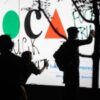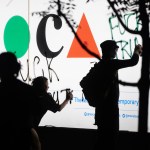The American West is vast enough to contain innumerable stories. Yet for generations, American movies, books and paintings have told relatively few of those tales, almost always centered on people of European descent. The Smithsonian American Art Museum takes a significantly broader view in “Many Wests: Artists Shape an American Idea,” an exhibition organized in collaboration with four regional museums that are west of the Rockies. The show contains the work of 48 modern and contemporary artists, most of whom identify as Asian American, Black, Indigenous, LGBTQ+ or Latinx.
The selection includes paintings, photographs, prints, sculptures and video, often in traditional modes but sometimes more conceptual. At opposite ends of the show — literally as well as figuratively — are works by Angel Rodríguez-Díaz and Raphael Montañez Ortiz. Rodríguez-Díaz’s “The Protagonist of an Endless Story” is a painted portrait, bold and affirmational, of Chicana novelist Sandra Cisneros in front of a bright red sky. Montañez Ortiz’s more disruptive “Cowboy and ‘Indian’ Film” is a literal re-cut of director Anthony Mann’s 1950 Western, “Winchester ’73,” whose celluloid strips the artist hacked with a tomahawk and reassembled into a video collage by means of a made-up ritual in honor of his Yaqui Indigenous heritage.
Aside from Montañez Ortiz’s chopped-up cowboys, the show almost entirely forgoes representations of 19th-century European American settlers. One notable exception is literally and symbolically pointed: Angela Ellsworth, a multidisciplinary queer feminist artist and fifth-generation Mormon, made pioneer women’s bonnets bristling with pins to represent Joseph Smith’s 35 wives.
Most of the artists are contemporary, and only a few of the earlier ones began working in the first half of the 20th century. Among those is Jacob Lawrence, who’s well-known to Washington museum-goers. “The Builders” is one of his many paintings of African American laborers. Less familiar is New Mexico’s Awa Tsireh (also known as Alfonso Roybal), who depicted Pueblo ceremonies and designs in precise, partly abstracted pen or pencil drawings augmented by watercolor. They appear both illustrative and mythic.
Not all the participants are new to the museum, or at least to the building it shares with the National Portrait Gallery. A portrait of Polly Bemis, a renowned Chinese-born Idaho business executive depicted in a swirl of flowers and Mandarin ducks, was painted by Hung Liu; the Chinese American artist was the subject of a 2021 Portrait Gallery retrospective that opened just a few weeks after her death. Ken Gonzales-Day digitally alters photographs of vigilante violence — mostly lynchings — to remove the bodies of Native American, Asian American and Latinx victims; some pictures from this series were shown at the Portrait Gallery in 2018.
Also included are 48 photos from Marcos Ramírez Erre and David Taylor’s “Delimitations Portfolio,” which documents the U.S.-Mexico border established “forever” by an 1819 treaty but erased just 27 years later by the Mexican American War. This project was featured at D.C.’s Mexican Cultural Institute in 2016.
One set of photos functions as a sort of preview. Lampooning natural history museums, Apsáalooke/Crow artist Wendy Red Star photographed herself in four seasonal settings as if in museum dioramas. The scenes might appear authentic initially but are betrayed by such details as plastic flowers and inflatable animals. Red Star is one of six artists who have created alternative monuments for the “Beyond Granite: Pulling Together” installation that will run on the National Mall from Aug. 18 to Sept. 18.
Four of the artists are Japanese American, and while two of them employ or adapt traditional East Asian styles, all but one respond to aspects of World War II. Wendy Maruyama and Roger Shimomura address the incarceration of people of Japanese heritage in U.S. prison camps. Both depict Idaho’s Minidoka camp, she with a massive hanging sculpture of paper name tags of internees, and he with a large camp scene in the style of a 15th-century Japanese painted screen.
The black silhouette of an American soldier, observing the prisoners, looms over Shimomura’s vignette. Patrick Nagatani, who was born days after the U.S. atomic bombings of Japan, portrays a different sort of shadow: the specter of nuclear war. His photographs of test sites, uranium mines and military installations illustrate perhaps the most momentous way the American West became a place of global significance.
A product of SAAM’s Art Bridges Initiative, “Many Wests” was organized by the museum’s Anne Hyland and E. Carmen Ramos; the Whatcom Museum’s Amy Chaloupka; the Boise Art Museum’s Melanie Fales; the Utah Museum of Fine Arts’ Whitney Tassie; and Danielle Knapp of the Jordan Schnitzer Museum of Art, University of Oregon.
Many Wests: Artists Shape an American Idea
Smithsonian American Art Museum, Eighth and F Streets NW. americanart.si.edu.
Dates: Through Jan. 14.
Prices: Free.
This post was originally published on this site be sure to check out more of their content.






